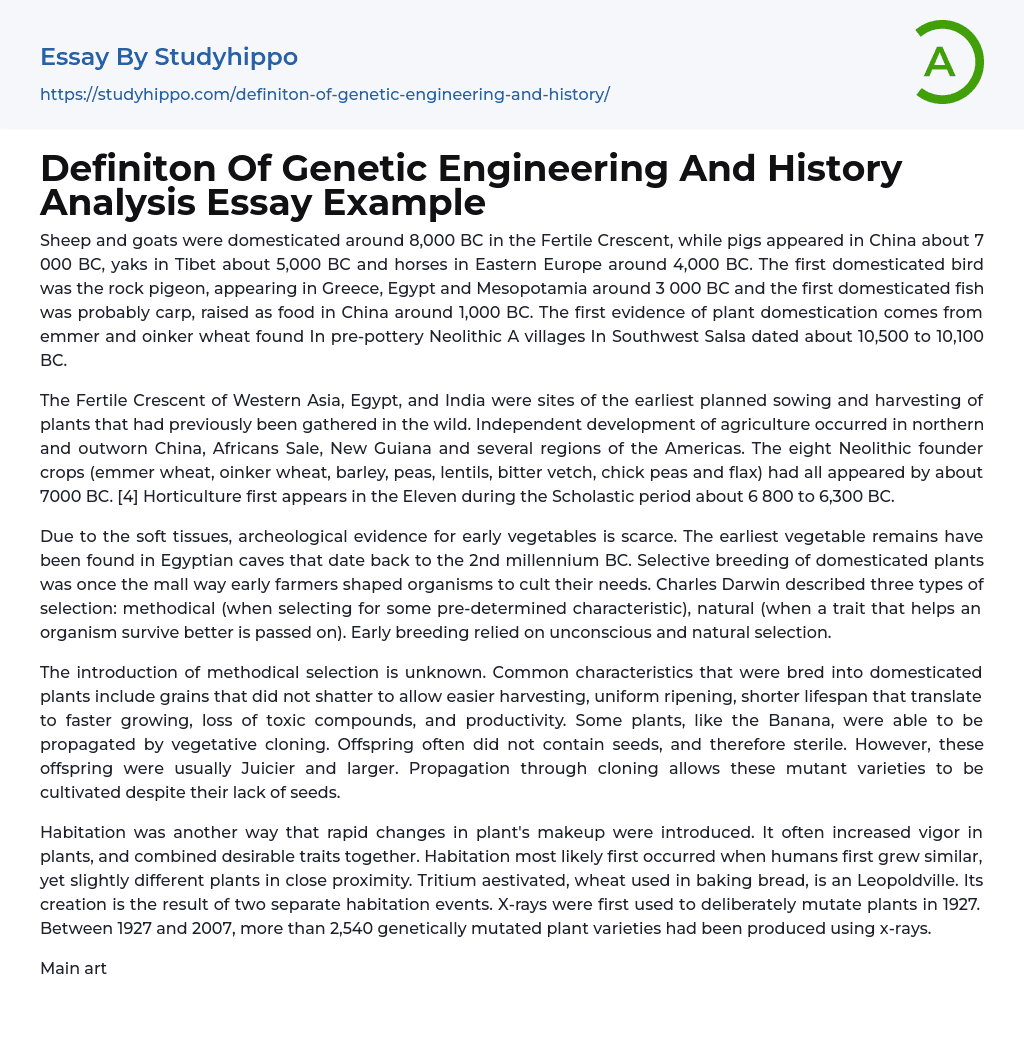

Definiton Of Genetic Engineering And History Analysis Essay Example
Sheep and goats were domesticated in the Fertile Crescent around 8,000 BC. Pigs were first domesticated in China around 7,000 BC. Yaks were tamed in Tibet about 5,000 BC, and horses were domesticated in Eastern Europe around 4,000 BC. The rock pigeon was the first domesticated bird found in Greece, Egypt, and Mesopotamia by 3,000 BC. Carp is believed to be the earliest domesticated fish raised for food in China around 1,000 BC.
The evidence of plant domestication comes from emmer wheat and oinker wheat discovered in pre-pottery Neolithic A villages dating back to about 10,500 to 10,100 BC across regions such as the Fertile Crescent of Western Asia, Egypt,and India where early humans started cultivating plants that used to be gathered from the wild.
Independent agricultural development also occurred in northern and eastern China,Africa's Sahel region , New Guinea ,and various parts of the Americas.By approximately7 ,000BC., eight Neolithic founder crops had emerged: emmer wheat,oinker wheat barley peas
... lentils bitter vetch chickpeasand flax.
DuringtheScholastic periodaround6 ,800to6 ,300B.C.E,horticulture made its first appearance.However,due to soft tissues' delicate nature,the archaeological evidence for early vegetables is limited.The oldest vegetable remnants discoveredin Egyptian cavesdatingbackto thesecond millennium BCE reveal that early farmers primarily used selective breedingofdomesticatedplants to manipulateorganisms accordingto their needs.Charles Darwin classified selection into three categories: methodical selection, natural selection, and unconscious and natural selection employed in early breeding techniques. The origin of methodical selection is still unknown. Selective breeding for cultivated plants aimed to acquire specific traits such as non-shattering grains for easier harvest, uniform ripening, shorter lifecycles for faster growth, elimination of toxic compounds, and increased productivity. Certain plants like bananas were reproduced through vegetative cloning resulting in seedless an
sterile offspring that were juicier and larger. Despite the absence of seeds, these mutated varieties could still be grown due to cloning. Habitat also played a role in introducing rapid changes in plant composition by enhancing vigor and combining desirable traits. This likely occurred when slightly different plants were co-cultivated by humans, as exemplified by the development of Triticum aestivum—a wheat variety used for baking bread—resulting from two separate habitat events. In 1927, x-rays were intentionally employed to induce mutations in plants. Utilizing x-rays from 1927 to 2007 led to the creation of over 2,540 genetically mutated plant varieties. The history of genetics has witnessed numerous significant discoveries that have greatly contributed to the advancement of genetic engineering. In 1865, Gregory Mendel conducted experiments with pea plants where he observed the concept of genetic inheritance.
(Note: are not displayed here)Mendel's initial evidence for the segregation and independent assortment of hereditary traits was largely ignored for over thirty years. In 1889, Hugo De Varies introduced the term "(pan)gene" to describe the units responsible for inheriting characteristics. William Battens coined the term "genetics" in 1905. Frederick Griffith demonstrated in 1928 that there is a "transforming principle" involved in inheritance, later identified as DNA by Avery, McLeod, and McCarty in 1944.
Edward Laurie Datum and George Wells Beadle developed the central dogma in 1941, stating that genes code for proteins. James Watson and Francis Crick discovered the double helix structure of DNA in 1953. Tools were needed to effectively manipulate DNA and understand its functioning.
In Hamilton Smith's laboratory during the 1970s, restriction enzymes were discovered that allowed precise cutting at specific locations and separation on an electrophoresis gel. This
breakthrough paved the way for advancements in isolating genes from an organism's genome.
Additionally, in 1967, DNA aliases capable of joining fragmented DNA together were discovered. The combination of two enzymes resulted in a technique allowing for cutting and pasting of DNA sequences known as recombinant DNA technology.
Plasmids, which were discovered in 1952, played a crucial role in transferring information between cells and replicating DNA sequences.Frederick Ganger's invention of a DNA sequencing technique in 1977 expanded researchers' access to genetic information. The polymerase chain reaction (PCR) has also played a key role in identifying and isolating genetic material.
- Russian Empire essays
- Ancient Greece essays
- British Empire essays
- Historical Figures essays
- Nazi Germany essays
- Roman Empire essays
- War essays
- Revolution essays
- 19Th Century essays
- Historiography essays
- History of the United States essays
- 20Th Century essays
- World History essays
- Vikings essays
- Declaration of Independence essays
- Civilization essays
- Evidence essays
- Genocide essays
- Colonialism essays
- Rebellion essays
- 1960S essays
- 1920S essays
- 1950S essays
- Letter from Birmingham Jail essays
- Louisiana Purchase essays
- The Columbian Exchange essays
- World Hunger essays
- What is History essays
- Bravery essays
- Gilded Age essays
- Vladimir Lenin essays
- Alexander The Great essays
- Sparta essays
- Victorian Era essays
- Henry v essays
- Stonehenge essays
- Frederick Douglass essays
- Mahatma Gandhi essays
- Joseph Stalin essays
- Geert Hofstede essays
- George Eliot essays
- Ginevra King essays
- John Keats essays
- Siegfried Sassoon essays
- Ben jonson essays
- Billy elliot essays
- Wilkie collins essays
- John Proctor essays
- Harriet Tubman essays
- Napoleon essays



